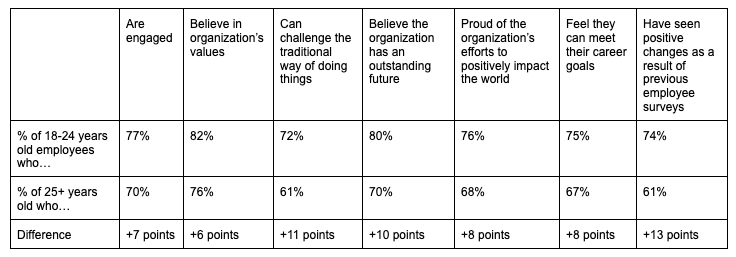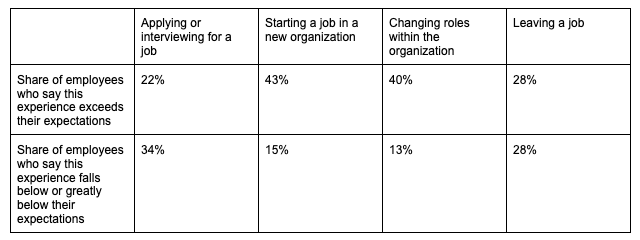Cut the Chaos: Qualtrics Announces Top Employee Experience Trends for 2025
Employees are more engaged where the culture helps them adapt to change
Despite their reputation, the youngest workers (18-24 years old) are most optimistic
Last updated: October 17, 2024
PROVO, Utah & SEATTLE, Oct. 17, 2024 – Today’s employees would like to get back on task. Years of chaotic workplace changes – think hybrid working arrangements and tracking multiple projects across different platforms have employees yearning for a simpler, productive 9-to-5, according to the sixth annual Employee Experience Trends Report from Qualtrics, drawing on insights from more than 35,000 employees in 23 countries around the world,
The five employee experience trends for 2025 are:
+ 2025’s best employers will make work less chaotic: The pace of change is putting pressure on employees, and they need organizational support to stay engaged and maintain their well-being.
+ Young employees are (surprisingly) optimistic…for now: Workers under 25 years old are highly engaged and have a positive outlook on the success of their company as well as their own careers.
+ Employee experiences are being ruined by entry and exit: Employees rank the application and interview process as the worst part of the employee journey, risking company reputations.
+ Prioritizing short-term gains are costing you long-term trust: While most employees believe in the competence and integrity of their senior leaders, just 56% believe they would prioritize employee well-being above short-term gains.
+ PSA: Your people are outpacing you on AI: Only about half of employees say they have training and ethical guidelines around using AI at work.
2025’s best employers will make work less chaotic
Amid rapid change to the workplace, employees are more engaged when their employer’s culture and processes empower them and make it easier to do their jobs. A culture of continuous improvement is the strongest predictor of employee well-being, yet it’s trailing as one of the lowest rated metrics among global employees.
Nearly 40% of employees report feeling pressure to be more productive. The pressure primarily comes from trying to keep up with the pace of change, as well as the overall economic environment and strategic changes to the business. When employees feel pressure, they are less engaged and their well-being suffers.

Leaders can ease this pressure by helping employees understand and adapt to changes – in fact, these are the top actions leaders can take to exceed employee expectations.
“Over the past several years, we’ve seen that engagement and well-being are highest when employees feel proud of their organization’s impact on customers and supported in adapting to change.” said Dr. Benjamin Granger, Chief Workplace Psychologist at Qualtrics. “In general, humans are excellent at adapting to change, as long as they have support. Increased pressure to be productive must be met with increased organizational support and communication if organizations are to uphold their end of the new psychological contract between employee and employer.”
Young employees are (surprisingly) optimistic…for now
Workers under 25 are bringing highly engaged, optimistic energy to work. They want to drive change, and have an overall positive outlook on their company’s future, as well as their own.

But don’t count on them for the long run: The one metric where young workers trail older generations is their intent to stay with a company for three or more years, even when they feel their employer exceeds their expectations.
Some of this could be due to typical demographic patterns. Young people may be more flexible about making major life changes more frequently. Still, leaders who want to retain this bright and valuable cohort can prioritize these things:
Top drivers of intent to stay for employees 18-24 years old:
+ My career goals can be met at this company
+ Employee benefits meets my needs
+ Manager behavior consistent with company values
+ Believe in the company values
+ Have meaningful career development discussions with my manager
“When leaders accept stereotypes about young employees being lazy, entitled, or disengaged, they do their organizations a disservice. Crushing the optimism young workers bring into the workplace is far from productive, especially when it can be easily nurtured, bringing out creativity and new ideas for innovation,” according to Granger. “Offering them opportunities to share their ideas and stretch their skills can win over talented workers early in their careers and create lasting goodwill toward the company, even after they eventually depart.”
Employee experiences are being ruined by entry and exit
Employees who have been with their current company for less than six months don’t plan to stay long-term. More than half of these new employees (56%) plan to leave within three years, compared with just 34% of more tenured workers. Why? Because companies are souring their new employees’ morale before they even start by providing poor job candidate experience. In fact, the candidate experience is rated lowest among several significant phases in the employee journey, such as onboarding, changing roles or applying for a promotion.
At the other end of an employee’s time with a company, the exit experience was also poor. While departed employees are no longer active with a company, their final impression can become the lens through which they view their entire experience.
“Potential and past employees are often overlooked when it comes to a company’s reputation, and organizations take on unnecessary risk by neglecting to address these bookend experiences,” said Granger. “Candidates and former employees can still influence others’ opinions about the company, good or bad. Organizations that invest in these first and final impressions gain a significant advantage in attracting talented candidates in the future, some of whom return to the company with enhanced skills and experiences.”

Prioritizing short-term gains are costing you long-term trust
More than two-thirds of employees believe their senior leaders are both competent and act consistently with the organization’s values, but only 56% believe they will choose employee well-being over short-term gains.
Business leaders are challenged by an uneven global economy and declining customer loyalty, but the long-term success of the company is at risk if they overlook the importance of employee trust.
“Trust is the glue that holds people within organizations together, but it is often harder to earn and maintain during times of disruption and uncertainty,” said Granger. “Most leaders are comfortable tracking operational metrics, but the ones who earn employee trust go further to monitor how employees feel, and double down on trust building-behavior and communication during challenging times.”
Trust is highly correlated with employee engagement, as well as employees’ sense of inclusion and well-being. Employees who trust their leaders are more open to changes, receptive to communication and overall act in ways that ultimately benefit the organization.
Employees are more likely to trust their leaders when:
+ Senior leadership responds to feedback from employees
+ Senior leadership values diverse perspectives, even if different
+ There is open and honest communication at this company
+ Work processes allow employees to be as productive as possible
+ Company continually improves how work gets done
PSA: Your people are outpacing you on AI
Employees are outpacing their employers on AI adoption, as enablement lags. Nearly half of employees say their organizations don’t provide AI enablement and training, and a similar share say their company has no clear AI guidelines, ethics or principles – or they are unaware they exist.
Meanwhile, nearly a third of employees who use AI at work are using tools that they found themselves, as opposed to tools provided by the company, meaning they likely have not been approved by IT or security teams and may not have safeguards to protect company or customer data. Nearly half (45%) of employees say they are using AI daily or weekly, and employees who use AI regularly are more positive about its potential for their job than employees who rarely use it.
“There’s a growing desire and readiness among workers to leverage AI, even if it isn’t explicitly supported by the company,” said Granger. “This introduces significant risks to employees, customers, and organizations alike. Many workers are already looking for opportunities to use AI to augment their work and it is far better for organizational leaders to lean in and provide approved tools and clear guidance to gain the benefits of these technologies without putting the company or customers at risk.”
For the full report and methodology, click here.
About Qualtrics
Qualtrics, the leader of the experience management category, is a cloud-native software platform that empowers organizations to deliver exceptional experiences and build deep relationships with their customers and employees. With insights from Qualtrics, organizations can identify and resolve the greatest friction points in their business, retain and engage top talent, and bring the right products and services to market. Nearly 20,000 organizations around the world use Qualtrics’ advanced AI to listen, understand, and take action. Qualtrics uses its vast universe of experience data to form the largest database of human sentiment in the world. Qualtrics is co-headquartered in Provo, Utah and Seattle. To learn more, please visit qualtrics.com.